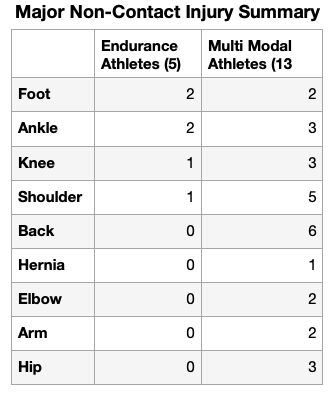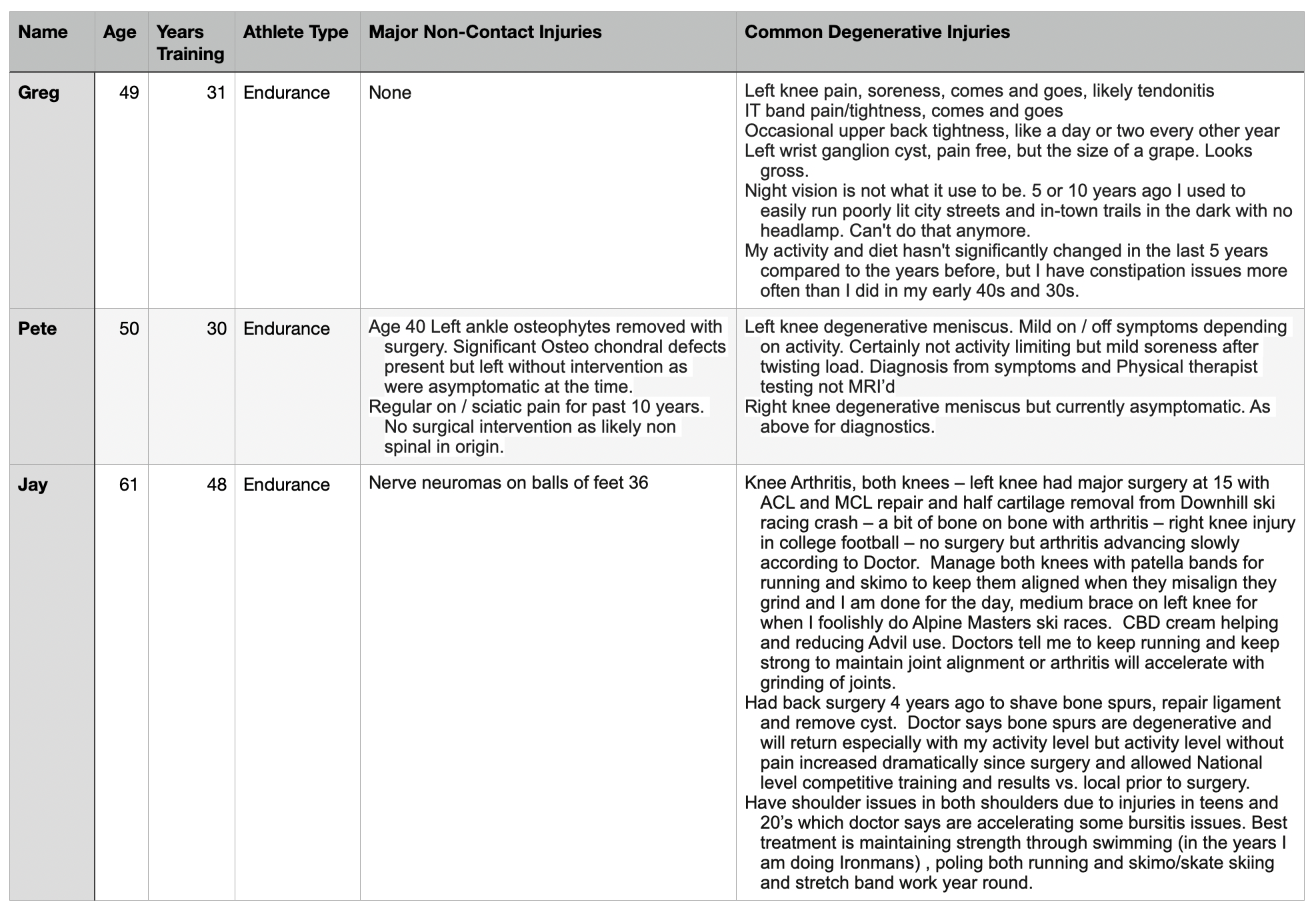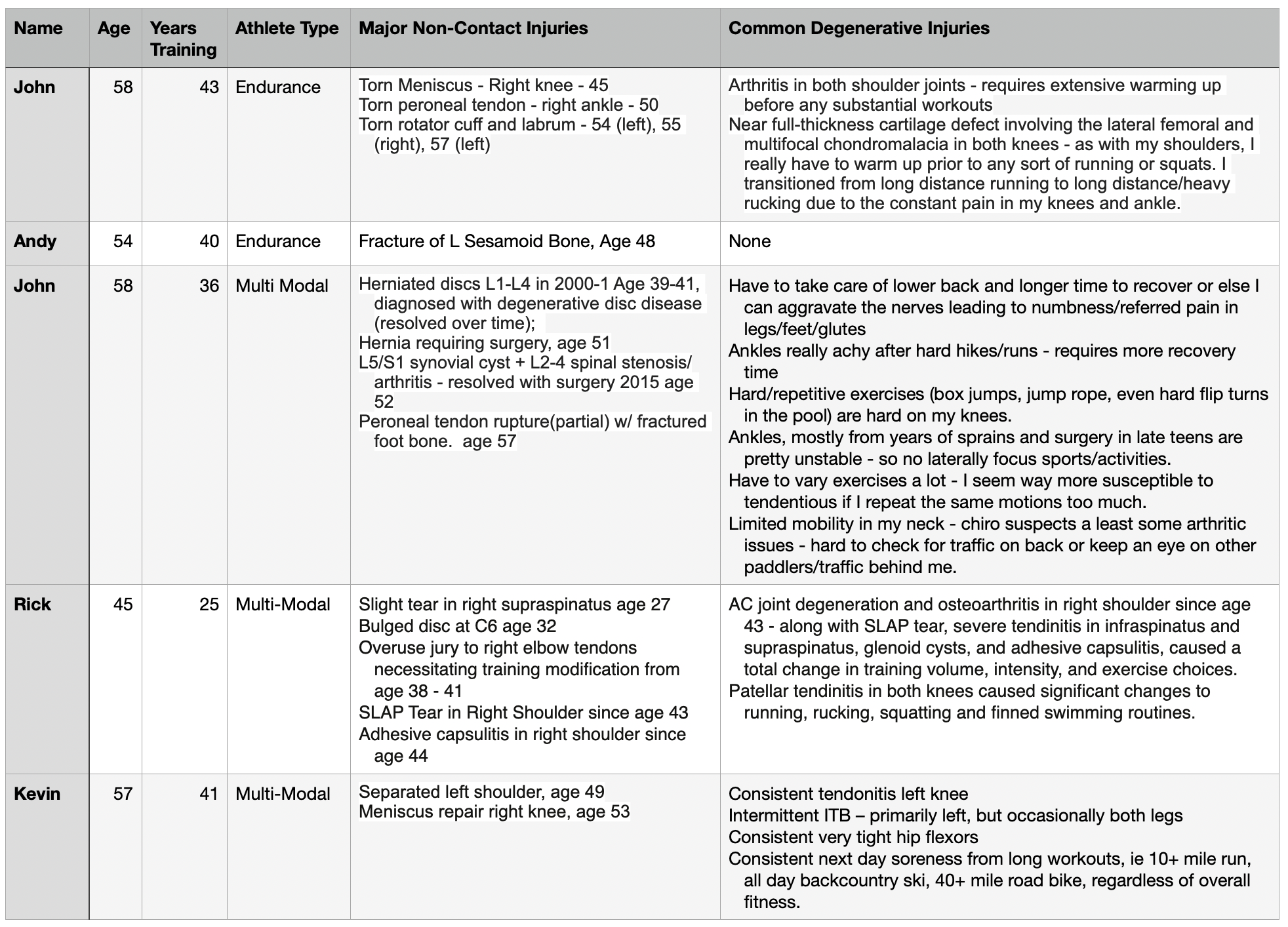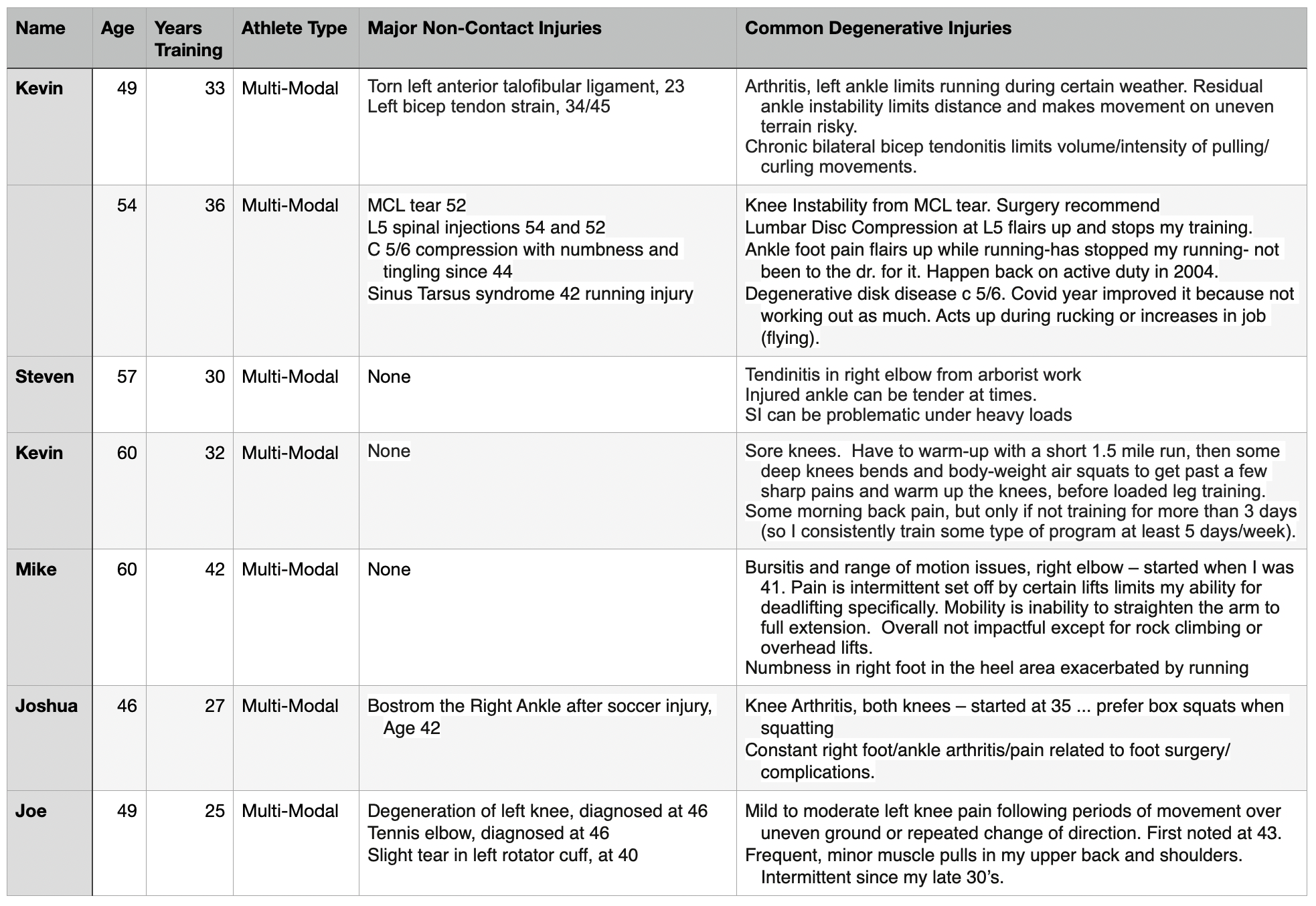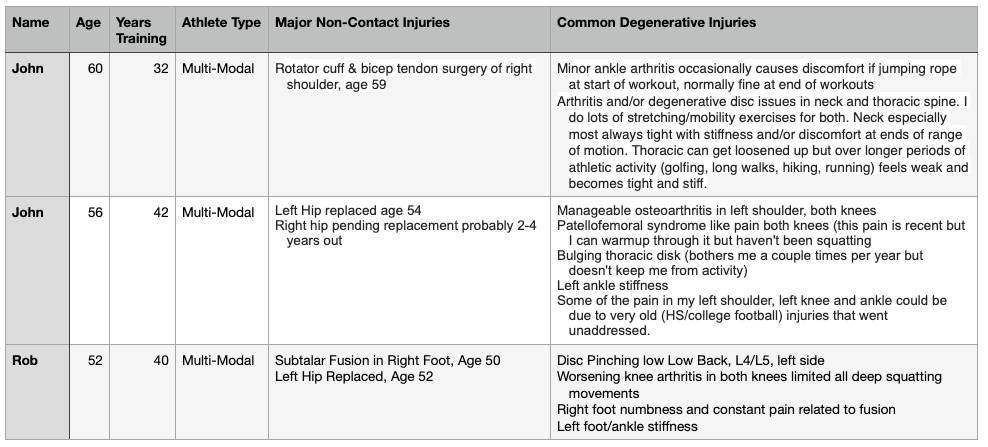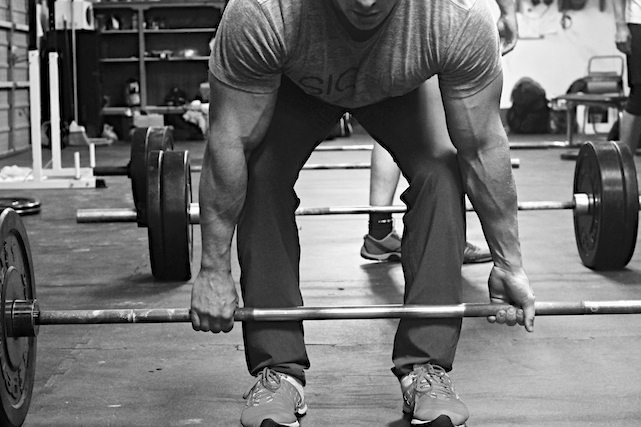QUESTION
I have a long-term goal of getting back to mountaineering in a year or more, and I am looking for a general base-fitness program to get started. I don’t have a gym membership but have some equipment at home such as barbells and a step up platform. I haven’t worked out in 9 months and need to slowly get started. I have some level of fitness, extensive hiking experience and some mountaineering experience. I have attempted Rainier twice, and believe I didn’t make the summit because I wasn’t strong enough, so I need to revisit how I train for an event like this. I need a better training program.
I am considering purchasing the “Mountaineering & hiking prep to get started on my long road back. Is this the best place to start? is this plan a one-time purchase or a subscription?
Thanks for your advice.
ANSWER
1-time purchase.
– Rob
QUESTION
I have been following your company for some time now, and have used an MTI training plan previously. However I am not sure if that plan was best suited to my goals, so I wanted to contact you for some advice.
Currently, I am an aspiring military member, however I am unsure on the exact timeline of when this will happen, so I want to start training. My current goal is to, approximately 2 years from starting serious physical training, be able to start your Operator Ugly Train up. This goal falls in line with my goal of not only joining the military, but completing a special operations pipeline.
My current state of fitness, on a scale of 1-10, would be a 2 or 3. I workout about 2-3 times per week currently, with my weakest area being running. Also, I currently belong to an organization that requires that I pass a PFT that includes max Hand Release Push-ups in 2 minutes, a plank (maxing out a 4:15 minutes), and a 1.5 mile run. The next time I take this test will be around January 30th. Besides this my ankle mobility is not very good at the moment, as I find my ankles overly stiff when I try to run.
With this in mind, what training plan progression should I follow, considering my current level of fitness and my testing requirement, as well as my end goals.
Thank you for your time and I look forward to hearing your suggestions.
ANSWER
You only have 7 weeks until Jan, 30, so you need to turn to the PFT. I don’t have an exact plan for you, but from what I do have I’d recommend the
USAF PFT Training Plan, which includes push ups, sit ups and a 1.5 mile run.
You could replace the situps in the plan with a plank. For the assessment, just do a max plank for time, and then for the progressions, replace the sit up reps with the according percentage of your plank time. So … if you did a 90 second plank on the assessment, and the progression calls for 5 rounds of 30% of your sit up reps, do 5 rounds of a 30 second plank, instead.
This is a six week plan. Repeat week 6 in the plan to stretch it to 7 weeks.
– Rob
QUESTION
I have used many of your programs and have had a lot of success with them. Currently I’m recovering from a kidney surgery that occurred 3 weeks ago. I’m unable to lift anything more than 10#s, strain, and really exert myself until December 23rd. More or less, limited to walking, light stationary biking, and light stretching (I’m doing what I can and I’m doing something everyday). My question is, when I’m cleared by the doc in couple weeks, what plan do you guys recommend I start with to restart my training? I’ll have access to a classic “globo gym.” I’m a career firefighter and Army National Guardsman. I’m also tentatively scheduled to attend WOCS for the army in February. Any insight would be much appreciated. Thank you and stay safe.
ANSWER
– Rob
QUESTION
I just recently started the PFT Prep program. It worked out perfectly that I found it exactly six weeks before my first scored test. I was wondering, how can I implement the chassis integrity work?
My hip flexors are typically a little short and now, with the focus being specifically on the test, they are getting a little more. Before this I was doing pretty standard S&C programming so there was a good balance of extension and rotation work mixed in. I figured chassis integrity would help balance it out but am wondering your thoughts.
ANSWER
– Rob
QUESTION
As always, have loved all the programming and feedback.
Since losing access to a full gym during my Greek hero cycle in the spring, I’ve completed: sandbag/db/weight vest, gratitude, and the sandbag cycle (logos, etc).
Trying to decide my next move: either humility into courage or start the Great Plains cycle.
Thoughts/ considerations?
ANSWER
Tribe Series …. simply because we’re not sure when the covid restrictions will ease up.
– Rob
QUESTION
I’m an Armor Officer in the Army, going to take over a Scout Platoon in January. I’m currently on quarantine, and won’t really in process the unit until the beginning of January. I need to be ready for both the APFT and the ACFT when I get to the unit in January.
The guy I’m replacing told me that our Squadron is still giving APFTs to new guys. I’ve never had much of an issue maxing PUs and SUs, I’ve just had issues maxing the run. Back at Benning I could run a 14:00 with ease and not be too winded. But I’m sure that the change in elevation is going to have a big effect on my run here. As far as the ACFT, the only events that I didn’t score in the 90s were the HRPUs (arched my back and was terminated at 30 reps) and the Ball Throw (barely made it 8 meters).
The Commanding General of 4ID has made off-post gyms and PT unauthorized. So I have to train from home. I have a 60lb MTI sandbag, 25lb weightvest, 40lb KB, and a barbell with 300lbs of plates. What plan(s) should I go with?
ANSWER
– You’ll need to build yourself a medicine ball, and I’m assuming you’ll find a tree or park somewhere with a pull up bar.
– Rob
QUESTION
I purchased your plans for Tactical Games, GoRuck Heavy and 5-Mile improvement plan. My question is how to combine them along with my current training. I do CrossFit 5-6x/week currently. Next year, I am signed up for 11 GoRuck events, including a Heavy, Tough, and Light (back to back to back), 5 Spartan events (Beast, Super, Spring, Stadion Sprint, 24-Hour Hurricane Heat, and DekaFit Challenge). I also have 4 Tactical Games scheduled, and then 3 run and gun competitions, these being 10k runs with shooting stages. These events are packed together so there isn’t really a way for me to be phasic about breaking the year down to where I can focus just on one thing for any period of time because each kind of event is scattered across the year more or less evenly.
SOOO…here’s what I need your advice on. I need to continue to keep CrossFit as a base. Training by myself is something that I can do once, MAYBE twice a week. I really don’t like it, but understand it’s necessary. So I’d like to have a day or two of solo training per week, but I can also do one moderate length or two or even possibly three smaller accessory workouts after I finish my daily WOD.
Would be happy to pay a little more if necessary to have you help me create an executable plan that I can stick to sustainably. Thanks, and I really like what your company offers.
ANSWER
Each of the programs you mentioned is a stand alone plan – and you can’t do this programming, and your crossift stuff concurrently. You’ll over train.
So what I understand you asking is if you can do crossfit, and do this programming 1-2 days/week?
Answer is no. These plans are progressive – ie the programming builds upon itself, and designed to be completed the weeks directly before your event. As well, the programming in several of these plans is high volume and intense – and you’ll overtrain by doubling up.
Understand the GoRuck and Spartan Beast/Super, 24 hour events are endurance focused, and your crossfit programming won’t prepare you to excell at these – though you might survive them.
So, if you want to continue doing crossfit, then I’d recommend adding rucking and ruck running (25#) to your programming to build endurance. You could follow the ruck programming in the GoRuck Plan for the progressions.
– Rob
QUESTION
I was hoping to get some programming guidance. I am shooting to do the Georgia smoke divers course early summer, this will depend on covid and qualifying for the course. As such I do not have a defined date and will need to jump when the opportunity is available. Is there a series of plans you would recommend leading up to the smoke diver prep plan you have created? I am planning on running that the last 7 weeks before. Thank you so much for any guidance!
ANSWER
– Rob
QUESTION
I first heard of you on the Beyond the Kill podcast many months ago. Since then I have booked a mountain goat hunt in BC – as of right now I am still scheduled for the first half of September 2021. We shall see if the border opens to tourists by then.
I graduated from the Naval Academy in 1983 – that makes me almost 60 years old. I will turn 60 in February. I spent 20 years on active duty. Now I am a Shift Manager in eastern Nebraska.
Fitness background – I struggled for a great many years with my weight fluctuating from 165-205 pounds. I am 5’9” tall. Currently I weigh 165 and have been stable within a few pounds for over 5 years. I started running for fitness almost 9 years ago in ~March 2012. Currently, I primarily train for sprint distance triathlons, and running events up to half marathons.
Physical limitations – I injured my left elbow at the Academy (stupid O-Course!) and cannot curl more than about 20-25 pounds. The elbow slides out of joint if I do. There are several other exercises I can’t do either such as chin ups with an underhand grip etc. Fortunately it usually slides back into joint without assistance when I release whatever I’m holding. I also broke my right collar bone at the Academy (Field Ball – think lacrosse without sticks). It healed about an inch short, so my right shoulder rolls forward if I’m not paying attention to my overall posture.
Work challenges – I work a rotating, 12 hour shift schedule that makes using a plan laid out in a traditional week format difficult. Also, 2 workouts a day on a work day will not happen. Workouts on a work day are limited to about 45 minutes and I generally do them before I go to work to avoid an impact to my time with my wife. I have a home gym setup, but do not have the space for a squat rack. I have a treadmill, bike trainer (Wahoo Kickr Core model), dumb bells to 50 pounds, a bench and a barbell to 160 pounds, step up platform to 24 inches and a sandbag to 40 pounds.
With all these things in mind, where should I start? Can your programs be adapted to the limitations I laid out? What principles would I use to make those adjustments?
Thanks for your time. Hope to hear from you soon.
ANSWER
MTI programming is designed for the fitness demands of the event – not the incoming fitness and/or limitations of the athlete. As you know, and backcountry hunt in Canada for Goat is a significant event. There’s no “flatter” mountains, or “slower goats” for 60 year old guys who work 12-hour shifts. The fitness demands of the hunt are the same for everyone … which is why we program for the fitness demands of the event/hunt.
From our programming, I’d recommend the 29-week
Backcountry Big Game Hunting Packet. You’ll want to complete the plans/order in this packet the 29 weeks directly before departing on your hunt. The plans are progressive – increase in intensity and difficulty as you work through them.
I don’t have an easy answer for your time limitations, other than “the mountain doesn’t care.” A backcountry goat hunt has a significant mountain endurance component (uphill movement under load), and this packet of plans reflect that. There’s no way to shortcut training for endurance. You have to train long to go long.
By my county you currently have 38 weeks until Sept 1. Most the plans in the packet are 5-6 days/week, so one way you could start now and account for your age and slower recovery is to stretch out the programming by starting now and training 4 days/week. If not, I’d recommend the
Bodyweight Foundation Training Plan now, then beginning the packet 29 weeks before your hunt.
Elbow? Substitute exercises that aggravate it as necessary. Most of the programming is legs/lungs/core focused, so it might not be a big issue.
Sorry for the tough love …
– Rob
QUESTION
I am shipping out for Marine Corps OCS in May, and I wanted to know what plan/progression you would recommend this far out. Should I go ahead and run the OCS program several times leading up to my ship date or should I do a different program now and run the OCS program closer to May?
ANSWER
I’d recommend the
Marine OCS Training Plan now, then dropping into the plans/order in the
Virtue Packet, beginning with Humility, then re-completing the OCS Training Plan the 7 weeks directly before reporting.
– Rob
QUESTION
I’ve recently come across your training programs and im incredibly interested. I’ve worked as a search and rescue medic in Colorado for the past 3 years so im in relative good shape. However im ready to make the step up to widland firefighting, but obviously don’t want to go in unprepared phsycially. The ultimate goal is to become a smokejumper, so I purchased that program a couple weeks ago. However early on I found my body is just not ready for that intensity yet. What program would you recommend for a rookie wildland firefighter?
ANSWER
These plans are designed as day-to-day, off season training for Wildland Firefighters and concurrently train strength, work capacity, mountain endurance (run, uphill movement under load, ruck) and chassis integrity (functional core).
– Rob
QUESTION
I am currently working on Fortitude V2 (week 1) as part of the Ruck-Based packet. I am in a situation where I may have to leave town where I wont have access to a full gym. Not sure how long is the stay, up to a couple of weeks perhaps. What I can bring with me at best would be a 60lbs sandbag, Army rucksack, some weight plates, and a 25lbs pair dumbbells. Wish I have a flatbed truck.
I will be lacking the weight to make the load heavy enough for the (3x, hard but doable) squats, walking lunge, curl and press, bench, and craig’s special. What exercises do you suggest as the alternative?
Also, what is your recommendation for improving grip? I have little to no equipment/setup for climbing. Best I can do now is simply attaching a FatGripz onto things while I go about doing the sessions.
Any suggested grip work routine outside the MTI sessions?
Thank you.
PS – stats for 3x:
Squat 300
Front squat lunge 205
Hang squat clean 225
Bench 230
Weight pullup 16(25lbs)
Push press 187
ANSWER
No quick answer for you to swap freeweight exercises to a sandbag/limited equipment exercises in the middle of the cycle. Best would be to drop out of Fortitude while you’re gone and pivot to Apache, then pivot back to Fortitude where you left off.
If not, do sandbag versions of the freeweight exercises and double or triple the prescribed load.
Extra Grip Work? Easiest is Time-based, dead hang intervals from a pull up bar. Do 5 rounds, max time dead hang, 60 seconds rest.
– Rob
QUESTION
Hope you are well. I’m wrapping up the BC Ski Preseason program and wondering how to transition from that into the heart of the ski season. I’ll be on the hill Saturdays and Sundays with a mix of skinning and boot packing and riding lifts. I’ll probably skin one other morning per week dawn patrol. I’m thinking I’ll try to do the Monday Tuesday and Thursday workouts from week six? I don’t have access to a full gym but have everything from the BC Preseason ski program.
Thoughts or suggestions?
ANSWER
Your plan is solid.
– Rob
QUESTION
So a more detailed explanation of my situation. I am trying to have a competitive package for BUDS in by the first week of February. I am currently intermittent fasting and have started the US NAVY PST package. I work out with my buddy who is doing the BRC package you guys have and we usually train together.
My first question is if I do the recon package with him, so we can motivate each other, will that do well enough to improve my PST. Or should I complete the PST package to better prep myself for the scores I need. Furthermore, should I continue with my intermittent fasting diet where I back load a lot of my food in the evening so I can have the nutrients in the morning as most of my workout times are in the morning around 0500.
Any help or guidance is greatly appreciated.
ANSWER
Answers:
1) Best to focus on the PST and do that plan.
2) I can’t speak to intermittent fasting, but if it’s not working for you, stop doing it.
– Rob
QUESTION
I am a US Navy Corpsman on the path to become a SARC with Recon and eventually MARSOC.
I am currently in the first week of the USMC RECON V2 plan.
I am slotted to go to PREP BRC/ BRC for Recon in APRIL2021 but that is not written in stone yet. Waiting on hard copy orders.
I am now also putting together a package for BUD/S because I’ve yet to get hard copy orders and it’s been a year since my RECON package has been accepted, so fuck it why not. We are allowed to run up as many different packages as we like until we get hard copy orders to one. To do so I’ll need to better my PST scores for a competitive package acceptance.
My question is: 1) should I continue and finish the RECON plan, begin the PST plan, then restart the RECON plan?
2) Or halt the RECON plan, begin the PST plan, then once complete begin the RECON plan
3) Something different.
The chances of the BUD/S package routing up and being selected before April2021 is a slimmer chance than getting hard copy orders for RECON, but either way I know I’ll need to be prepared physically to put out for a PST wether it be for the BUD/S package or the first day/ week of PREP BRC.
Loaded question I know, but before I found y’all I was so lost in the sauce trying to train on my own. Y’all take so much of the guess work out. Everyone I’ve talked to about MTI are big fans. I just need to make sure I’m taking the right path with the plans so I am well prepared for the ass whoopin’ I’ll be gettin. So thank you in advance for all the guidance and knowledgable detailed plans.
ANSWER
Go with 1) since you don’t know about BUD/s yet and at least you have a date for Recon.
You’ll want to re-complete the
USMC Basic Recon V2 Plan the 9 weeks directly before reporting. So after finishing it this first time through, if you haven’t heard about BUD/s and the PST, drop into the plans/order of the
Pirates Packet. These are designed as day to day training for full time SOF with water based mission sets and concurrently train strength, work capacity, endurance (run, ruck, swim), chassis integrity and tactical agility.
Then, re-start and complete the RECON V2 plan the 9 weeks directly before the course.
– Rob
Subscribe to MTI's Newsletter - BETA



